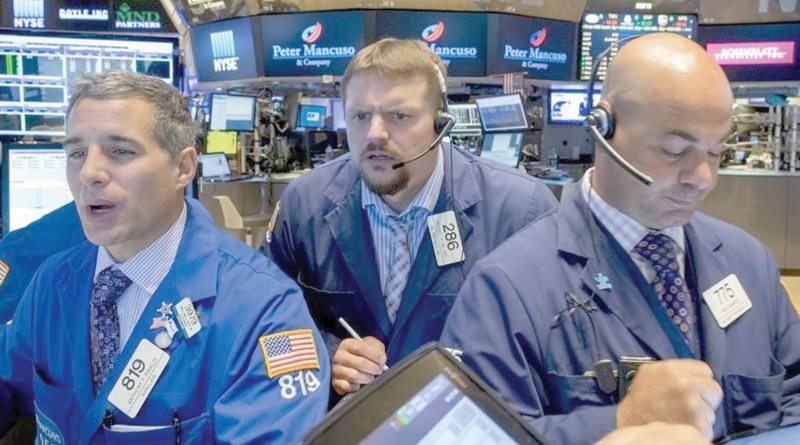

US STOCKS: Russell rebalance boosts trading volume * Indexes: Dow down 0.01pc, S&P up 0.16pc, Nasdaq up 0.46pc -
NEW YORK: Heading into second-quarter earnings season, investors are looking for a continuation of strong US company results to justify high stock valuations, now trading near their loftiest levels since 2004.
However, drilling a hole into that hopeful scenario is the current bear market in oil prices and an economy showing signs of growth below the pace expected earlier in the year.
“A lot of the expectation for a recovery in earnings is predicated on oil prices being around $47-$50 a barrel,” said Hugh Johnson, chief investment officer of Hugh Johnson Advisors LLC in Albany, New York. “So if you don’t get those numbers, you don’t get the strong earnings the stock market needs. This is not trivial stuff. It creates a lot of uncertainty and volatility in forecasts.”
US crude futures have been pressured lower by a supply glut. They’ve averaged over $48 per barrel so far this quarter, but traded around $43 on Friday and are down more than 20 per cent from February, when they hit an 18-month high.
US stocks are in the ninth year of a bull run which has been fuelled of late by bets on pro-growth policies from US President Donald Trump. However, with the timetable for reforms stretching further into the future, earnings are seen as a critical support for stock prices.
With indexes near record highs, there is speculation among Wall Street analysts about whether a correction is due.
Earnings expectations have dropped for 10 of 11 industry groups since early April, with only industrials looking better than they did then.
The benchmark S&P 500 stock index as a whole is expected to deliver 7.9 per cent profit growth, down from 15.3 per cent in the first quarter, and below the 10.2 per cent forecast in April, Thomson Reuters data shows.
On Thursday, Nike will be the first Dow component to report earnings for the most recent quarter. The season heats up in the second week of July.
Technology earnings are seen posting double-digit growth, helped by gains in semiconductor companies, and financials are close behind with estimated 8.1-per cent profit growth.
While lower energy prices can help some sectors such as industrials and transports, as well as boosting consumer sentiment, high expectations for energy earnings growth mean any stumble will be felt broadly.
Energy sector profits are seen up a whopping 683 per cent from a year ago, when many companies posted losses, according to Thomson Reuters data. Without energy, profit growth estimates drop to 4.8 per cent for the quarter.
Expectations for the sector will probably have to come down for the second half of the year if low oil prices persist, said David Joy, chief market strategist at Ameriprise Financial in Boston.
“The one wild card right now is the price of oil. Expectations that are baked into full-year forecasts assume a higher price for oil certainly than we have now,” he said. Energy has been the weakest performing sector so far this year, with the S&P energy index down near 15 per cent.
The drop in oil prices notwithstanding, some analysts have cautioned that Wall Street has been too optimistic about overall earnings.
Michael Purves, chief global strategist at Weeden & Co, cut his 2017 S&P 500 earnings estimates from $127 to $116, below the $131.51 consensus, as economic growth and inflation are not as high as expected.
An Atlanta Federal Reserve model recently forecast second-quarter economic growth coming in at a 2.9-per cent annualised pace, down from a previous 3.2 per cent.
Another hurdle for earnings growth: declining corporate buybacks.
“Over the past two years, more than 20 per cent of S&P 500 issues have given at least a 4 per cent tailwind for (earnings per share) via reduced share counts,” Howard Silverblatt, senior index analyst at S&P Dow Jones Indices, said in a note.
For the first quarter of 2017, that rate fell to 14.8 per cent of companies, and there are indications of “even less support” in the second quarter, he said.
US STOCKS: US stocks ended higher on Friday after a last-minute trading spike and a technology sector gain offset weakness in financial stocks and sent the Nasdaq higher, giving it a weekly gain for the first time in three weeks.
The energy sector rebounded and finished the strongest of the S&P’s 11 sectors with a 0.8-per cent rise as oil prices came back from multi-month lows.
Bank stocks ended lower even after they passed their annual stress test as some results were weaker than expected and investors focused on a flattening yield curve.
The healthcare rally faded on Friday as investors tried to decipher whether a Senate Republican bill to replace Obamacare, released on Thursday, would gain enough support to pass.
The sector closed down 0.1 per cent, clawing back some losses after it dropped sharply late in the session when Republican Senator Dean Heller became the fifth US Republican senator to say he would not support a healthcare bill unveiled by his party on Thursday. The sector still closed 3.6 per cent higher for the week. Trading volume jumped just before the close due to FTSE Russell’s completion of the annual refresh of its benchmarks.
The Dow Jones Industrial Average closed down 2.53 points, or 0.01 per cent, to 21,394.76, the S&P 500 gained 3.8 points, or 0.16 per cent, to 2,438.3 and the Nasdaq Composite added 28.57 points, or 0.46 per cent, to 6,265.25.
For the week, the Dow added 0.05 per cent, the S&P rose 0.21 per cent and the Nasdaq gained 1.84 per cent.
The S&P financial index, fell 0.47 per cent, with pressure from banking stocks after the stress test results and ahead of the second part of their test due on Wednesday. — Reuters
Oman Observer is now on the WhatsApp channel. Click here



